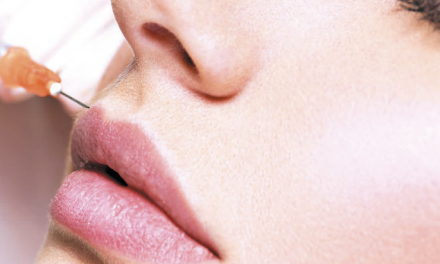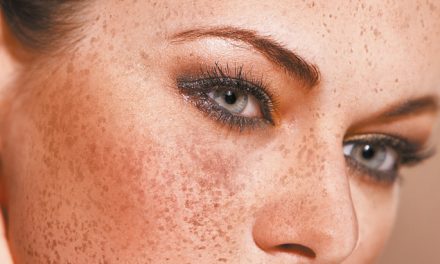Massirone Alberto and Lazzari Riccardo evaluate the effectiveness of a topical biomaterial for skin hydration in the form of a moisturising emulsion combined with pre-moisturising lotion
SKIN IS A COMPLEX AND MULTI-functional organ that is subject to an inevitable and complex process that can be described as intrinsic (chronological) and extrinsic (environmental) ageing. The major result is a loss of functional capacity, it manifests as an observable change in the external appearance of the skin, and it can be accelerated by multiple factors such as chronic exposure to solar irradiation, cigarette smoke or simply interaction with our environment with a loss of skin hydration1. The purpose of this study is to demonstrate the validity of a treatment to increase skin hydration using a dermo-cosmetic product based on alpha gluco-oligosaccharide and hydrolysed collagen in an emulsion, combined with a specific pre-moisturising lotion formulated to make it highly absorbable2–3.
Materials and methods
Subjects
Twenty female subjects divided into four homogeneous groups assimilated by age were selected for the study after the approval of an institutional review board and informed written consent. They were all disease-free at the time of the study and none of them, during the experimentation, declared to suffer from particular pathologies that, in some way, would have influenced the evaluative survey. Several parameters, clinical and instrumental, were monitored to assess skin condition during treatment. Group A collected the subjects between 25 and 35 years; Group B, between 36 and 45 years; Group C between 46 and 55 years; and Group D, between 56 and 66 years of age. The sensitive areas and key point of the evaluation have been limited to the face4.
Instrumental measurements
Our specialists collected health and clinical data resulting from instrumental measurements. Anamnestic data were recorded regarding general health status, underlying diseases, and specific details relating to the wellness of the skin through a medical interview and a facial check-up carried out with the support of Dermalab® Series SkinLab Combo–Cortex equipment. With Cortex equipment, we were able to evaluate cutaneous hydration, skin pH, cutometry (degree of elasticity of the skin), thickness and quality of the skin, as well as the variation of the skin’s composition (collagen, fibroblasts, etc.) by means of cutaneous ultrasound5–9 (Figure 1).
Product
Subjects were instructed to apply the product (Promedial Moisturizing Emulsion And Promedial Pre Moisturizing Lotion, Japan) to the face twice a day. The treatment involved the use of two products: first a pre-moisturising lotion, applied until complete absorption in the morning and the evening before bedtime, and a second phase product. The pre-moisturizing lotion required application to a cleansed face and, after a few moments, when the skin was completely dried, the second phase product in the form of a moisturising emulsion, in a thin veil, had to be homogeneously distributed over the entire area. We proposed an evaluation scale based on four temporal steps checking our patients’ progress every 30 days. All patients started the treatment at the same time. The treatment with the test products was carried out for 90 days.
Data analysis and statistical method
Measurements and clinical evaluation were carried out at baseline, T0 (before starting treatment) and then we carried out a further 3 evaluations every 30 days as follows: T1 (30 days from the start of treatment) after 30 days of use of the two products delivered, T2 after 60 days of use of the two products delivered, and T3 after 90 days of use of the two products delivered. Our group carried out the research during spring and early summer — from April until June 2017). At times, climatic conditions had some critical issues. Those changes were taken into account with different odds ratio calculated separately from the values of the experimentation (very hot days, strong solar irradiation, poor ventilation and poor rainfall had a considerable impact on the skin of the face as the area most exposed directly to climatic variations).
Careful preparation of all subjects before the instrumental evaluation was an essential part of the study. From the midnight prior to the examination they had to follow some simple rules: they should not wash, apply shampoo, or put makeup on the areas of the face to be assessed as part of the investigation. Investigators collected their instrumental parameters after micro-climatic acclimatisation of the patient for, at least, half an hour in the suitably air-conditioned waiting room. Biologic measurements were made in a controlled temperature and humidity space (24±2°C, 50±10% relative humidity). Then, we proceeded to collect all the individual data, evaluating, in particular, the correlation between the age of the volunteers and the baseline values of hydration, elasticity, pH, and structure of the skin via cutaneous ultrasound investigation.
Results of treatment efficacy
Hydration
The obtained data lead to the following consideration: an increase in mean hydration of 22.1% after 30 days, of 23.6% after 60 days, and of 26.8% after 90 days of daily treatments performed twice a day. Respectively, we have a statistical significance at 30 days (p <0.0378), at 60 days (p <0.0292) and at 90 days (p <0.0108) (Figure 3). However, we must take into account the hot weather that, in the last period of the experimentation, hit our latitude with humid days and with temperatures above the seasonal average. These meteorological indexes led to a significant spread in the last period’s parameters regarding hydration, due to the obvious effect of the abundant sweating. A conservative estimate can reduce the average of the values measured at T3 by 5–8%, thus bringing them to values between 25.46% and 24.66%.
Cutometry or cutaneous elasticity
Concerning cutaneous elasticity, we noticed a decrease in the time of skin realignment after suction, with an evident increase in elasticity. This phenomenon, as seen in Figure 4, occurred mainly in young and mature skin and, to a lesser extent, in the more mature skin of those over 55 years of age. The obtained hydration and the consequent cutaneous involvement accelerated the cellular activity over time, with the possible increase of fibroblastic activity and increase of collagen and elastin with a more active response in the younger subjects. The most mature subjects have generally improved their elasticity by 6–8%, and those between 66 and 75 years have improved between 3 and 5% compared to the results obtained in younger skin. Between the ages of 35 and 55 years, the increase in elasticity is optimally consolidated for this group with a value between 8 and 10%. We detect a statistical significance for all subjects up to 65 years at 30 days (p <0.0381), at 60 days (p <0.0095) and at 90 days (p<0.0155), while from 66 to 75 years the statistical value is less significant (p <0.878).
PH measurement
The pH maintained substantially unchanged values, except for a slight decrease towards acidity from an average value of 4.8 basal to 4.5 (-6%), even if on the hottest days there has been a slight increase in the values towards acidity (7–9%), these were most likely due to sweating (Figure 5).
Cutaneous ultrasound
After 30 days, cutaneous ultrasound showed an increase in cell activity, with a significant increase in fibroblastic activity, fairly constant in all age groups, which consolidated almost at the same values after 60 days, with a slight increase at the end of the evaluation after 90 days (Figure 6). We must consider the high temperature and the equally high humidity that occurred in June, which created cutaneous vasodilatation and may have favoured an increase in hydration. A part of the effect was generated by perspiratio insensibilis (insensitive perspiration: is a physiological process that consists in the continuous and imperceptible loss of small amounts of water from the skin, mucous membranes, and respiratory tract), which in itself helps to keep the stratum corneum moisturised, leading to a stimulation of the metabolic activity of the skin with an increase in elastin and collagen indices with significant improvement of the tissue texture. It is interesting to note this took place throughout the entire skin structure.
Conclusions
This evaluation led us to the conclusion that the constant use of the two products, the pre-moisturising lotion and the moisturising emulsion used twice a day, showed efficacy both in moisturising the skin and in promoting local cellular activity, with improvement of elasticity and fibroblastic activity already after 30 days from the start of treatment, with the achievement of a better level after 60 days, and an almost constant maintenance after 90 days. Further studies for a longer-lasting period could be performed to suppor these results.







